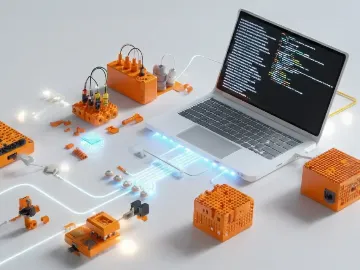Building an Internet of Things (IoT) solution or product is a multidisciplinary marathon. You need embedded engineers to develop firmware, connectivity specialists to ensure data exchange, and cloud DevOps to keep hundreds of devices online. Most organisations can't assemble that lineup in-house fast enough. Outsourcing IoT development to an experienced tech partner often solves the issue, but only if you approach it right.
In this guide, we share proven strategies for outsourcing IoT development effectively. You'll learn which project components to outsource and how to avoid challenges along the way. First, let's explore what makes IoT outsourcing an attractive option.
How companies benefit from outsourcing IoT development
Two major reasons businesses choose to outsource IoT development are the lack of specific skills and the desire to reduce development costs. While it can solve both of these issues, it also has a few other benefits.
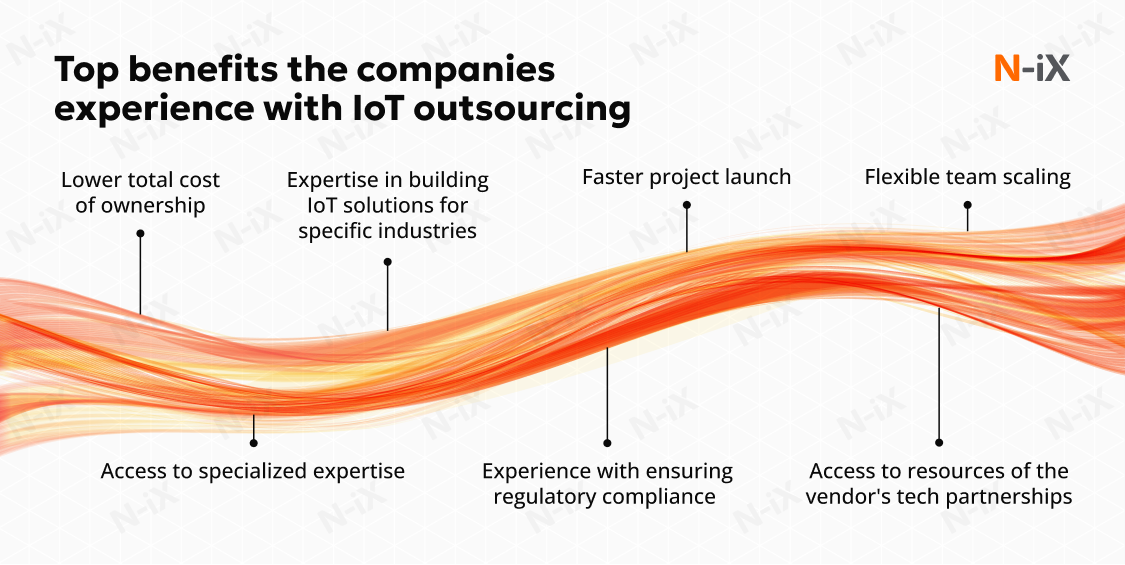
Global access to specialized expertise
Outsourcing IoT development gives businesses access to a global talent pool of IoT-related experts. This includes firmware and embedded engineers, connectivity specialists, cloud IoT architects, and cybersecurity experts. Hiring outsourcing developers can help you address the tech talent shortage in your country and avoid project halts. Also, an outsourcing partner ensures that your project will have a dedicated engineer for the task until the end of your project contract.
Faster project launch
Established IoT vendors can assemble cross-functional teams in just three to four weeks. This reduces typical launch times, helping you bring the solution to market faster and stay ahead of competitors.
Approach your IoT project avoiding major risks—get the guide!
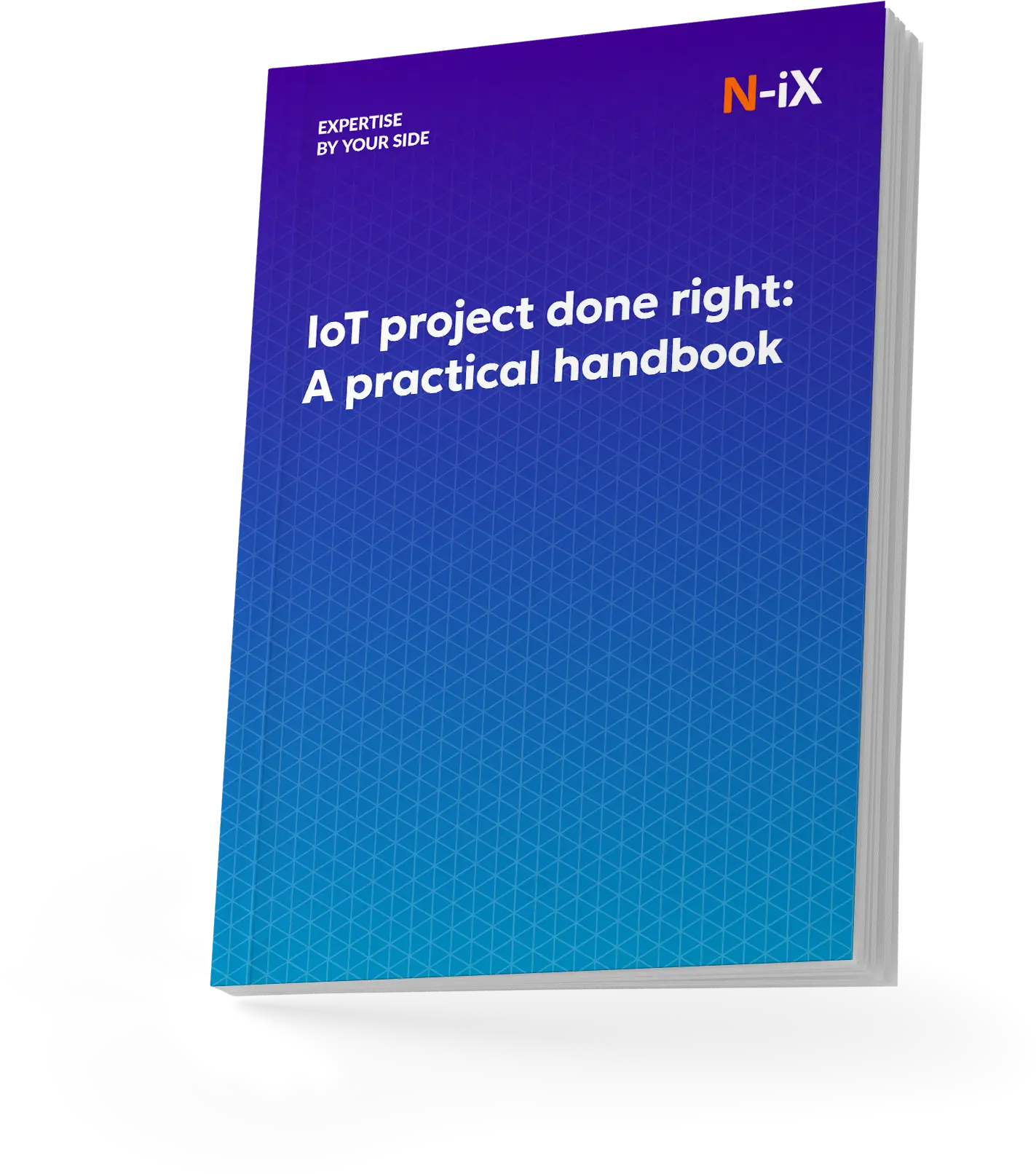

Success!

Lower total cost of ownership
When outsourcing IoT development, you can avoid recruitment fees and salaries during ramp-up. Moreover, you can also save up on the capital expense of running offices if you opt for specific IT outsourcing models, such as custom solution development or a managed team.
Experience with ensuring regulatory compliance
Some tech vendors are experienced in building development processes that meet specific standards, like ISO 27001:2013. They also design secure boot chains and create software bills of materials (SBOM). Familiarity with these processes can help shorten audit cycles for certification approvals and decrease the risk of costly redesigns.
Flexible team scaling
Some projects may have team fluctuation throughout the development process. You may need just a few engineers for the pilot to validate the concept. Then, as you move to a full-fledged development, you should bring more experts with different skills. Finally, once a stable release is made, you may need only a few engineers to maintain it. While in-house flexibility is possible, it can be costly. You'd still need to pay engineers even when their involvement is partial.
Outsourcing lets you pay only for the expertise you need, when you need it. This eliminates severance costs and idle salaries often associated with in-house projects. Moreover, access to experts on demand also helps you avoid project halts, usually associated with finding a new hire.
Access to resources provided by tech partnerships
Established IoT outsourcing companies often have partnerships with MCU, MPU manufacturers, connectivity providers, and cloud hyperscalers. When you outsource IoT development to such vendors, you can also access the benefits and resources from those partners. It may include tech support, early access to new features, special plans, and more.
Expertise in building IoT solutions for specific industries
A vendor's domain experience in IoT can help you optimize processes and implement best practices specific to your industry. For example, N-iX's expertise in IoT and embedded solutions for fleet management can benefit businesses in similar sectors. We already know the workflow specifics and approaches that are most effective for fleet management tasks. With our expertise in related domains, such as supply chain or automotive, we can help you customize the solution based on your specific business environment.
Companies may benefit from outsourcing IoT development by following different approaches. Let's review them.
Ready to delegate your IoT project? Review the best IoT software development companies that transform businesses
Most popular IoT outsourcing options: Onshore, nearshore, offshore
You can do onshore, nearshore, and offshore IoT development. This classification is usually based on the distance between your location and the outsourcing vendor. Let's take a look.
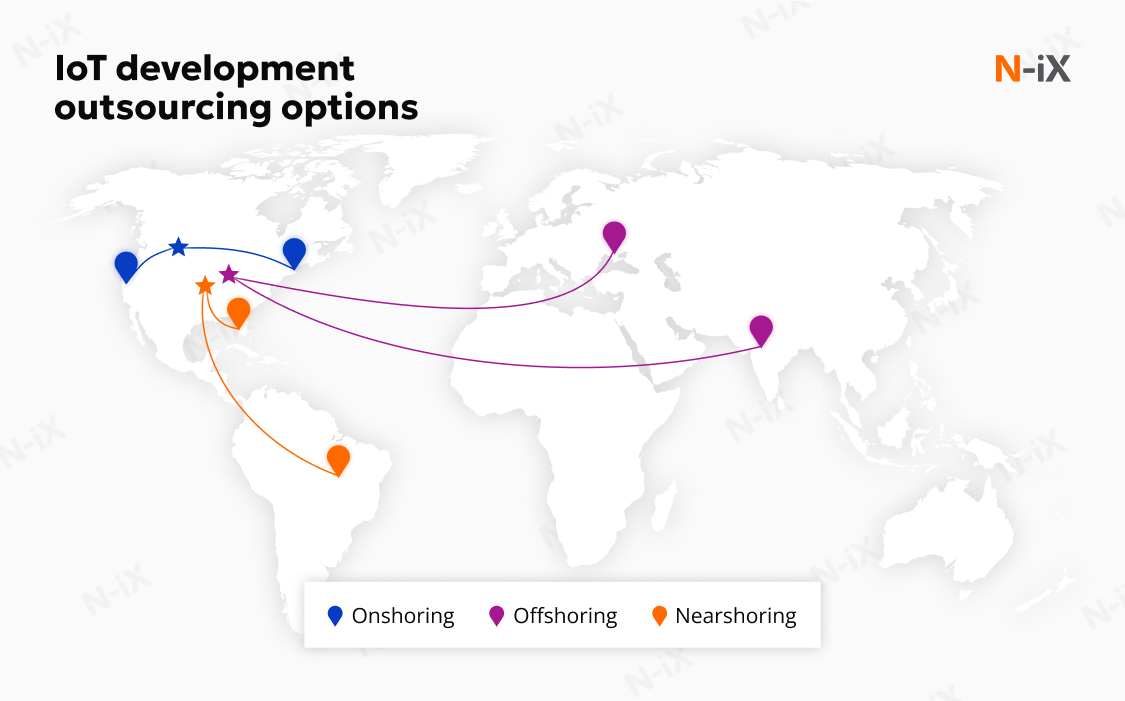
Onshore IoT development
Onshoring refers to relocating IoT development to lower-cost cities within your own country. For example, companies can move projects from expensive tech hubs like New York to more affordable regions such as South Dakota. This approach benefits businesses facing legal or contractual restrictions that prevent international outsourcing. Many domestic locations often offer lower living costs and IoT engineers' salaries. By choosing onshoring, companies can cut development expenses while keeping operations within the country.
Nearshore IoT development
When you nearshore IoT development, you outsource to vendors in nearby countries within your time zone. For example, a company in Florida might choose Colombia or other South American countries, benefiting from a minimal time difference. This proximity enables immediate problem-solving and continuous collaboration while reducing costs through lower regional salary requirements. The result is faster development cycles, fewer communication delays, and better outcomes for IoT projects that demand close coordination between hardware and software teams.
Offshore IoT development
Offshore software development for IoT projects involves partnering with teams in distant countries. Companies typically move projects from high-cost regions like the USA to more affordable locations such as Ukraine or India. This model works particularly well for IoT projects requiring specialized technical skills at budget-friendly prices. However, the distance may become an obstacle if you plan to visit the outsourcing center often.
|
Criteria |
Onshore IoT development | Nearshore IoT development | Offshore IoT development |
| Advantages |
|
|
|
| Disadvantages |
|
|
|
Often, the businesses combine in-house and outsourcing depending on the IoT solution type. For instance, a company in a highly regulated industry like healthcare may be legally required to keep certain operations in-house. However, they can still outsource non-core development tasks, reducing production costs. Below, we explore the typical ones that can be outsourced in IoT development.
Explore the topic: Top offshore IoT development companies in Europe
What can be outsourced in IoT projects?
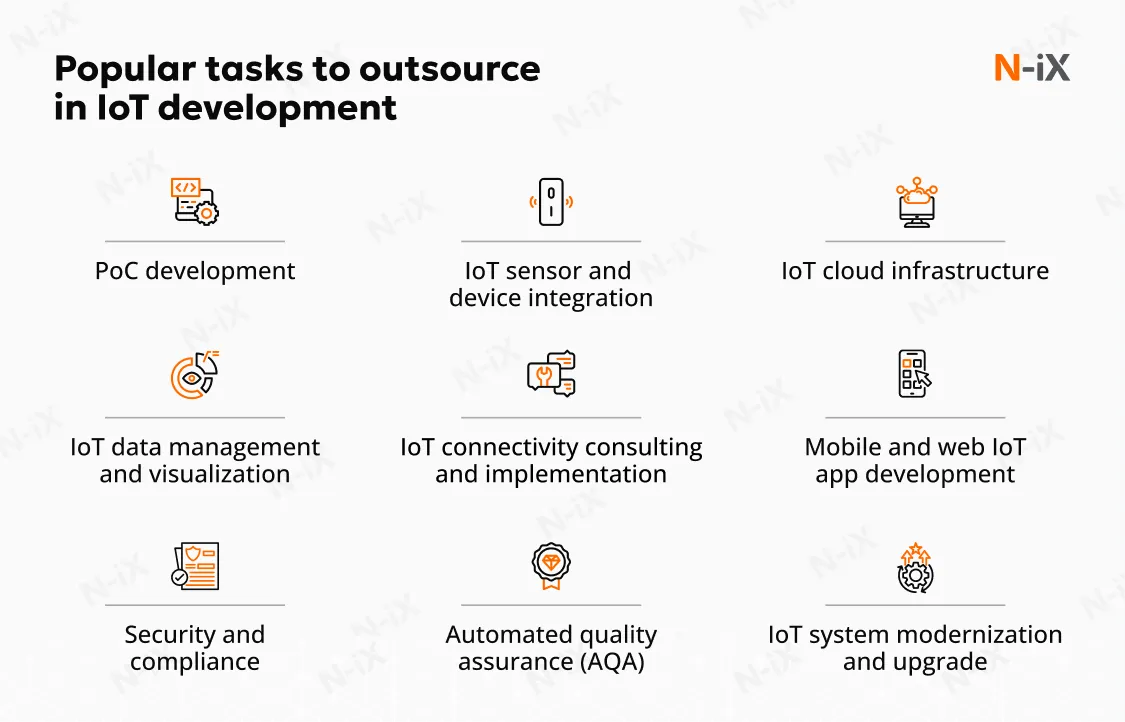
PoC development
Proof of Concept (PoC) development is a key stage, especially for new projects that don't have any analogue in the market. The outsourcing team can do rapid prototyping, validate feasibility, and test new concepts. After the initial validation, businesses can proceed with the project, reducing the risk of delays and unexpected redesigns during development.
Your advantage with N-iX: Our IoT solution architects ensure prototypes are built with scaling in mind. This means you don't just validate feasibility-you set a solid foundation for long-term growth.
IoT connectivity consulting and implementation
Establishing reliable connectivity for IoT devices is crucial for ensuring seamless data transfer and communication. Outsourcing partners can advise on the best connectivity type based on the business task, set it up, and design OTA updates. Engineers in IoT consulting firms can also assist in migrating from a wired to a wireless network, ensuring secure and reliable communication between devices and the cloud.
Your advantage with N-iX: We have experience with all major IoT connectivity standards, including LPWAN, NB-IoT, LTE-M, Wi-Fi, Bluetooth, and more. It helps our clients avoid costly overprovisioning while guaranteeing stable performance for both small pilots and mass rollouts.
IoT sensor and device integration
An experienced outsourcing team can integrate IoT sensors and devices into your existing infrastructure. These engineers manage the entire process, including configuration, calibration, and registration of devices. The team also integrates these devices with your IT systems, cloud platforms, and databases. Additionally, it supports connecting devices to on-premises or hybrid solutions for edge computing.
Your advantage with N-iX: An experienced IoT company like N-iX can also develop APIs and middleware. It can also assist with implementing robust security protocols.
IoT cloud infrastructure
IoT cloud computing provides essential processing power for remote device management and data analytics. Cloud infrastructure forms the backbone of IoT architecture, enabling seamless device connectivity and data processing. Businesses can enhance their IoT solutions by outsourcing cloud integration to specialized experts. This approach ensures systems remain reliable, scalable, and capable of supporting real-time analytics.
Your advantage with N-iX: The outsourcing vendors like N-iX have an extensive cloud development team with over 400 cloud engineers and partnerships with major cloud providers (AWS, Azure, GCP). These outsourcing partners bring access to advanced tools and proven expertise that less-connected vendors can't offer. For businesses, it means faster cloud adoption and reduced risks.
Building an IoT product? Consult the best 25 IoT product development companies worldwide to ensure its reliable performance
IoT data management and visualization
Different IoT devices generate plenty of data that has little impact if it is only collected. Outsourcing IoT development can help you create solutions to structure and process data. IoT engineers can also design data warehouses and architecture to organize and store large volumes of data. They develop customizable report-generation applications and business intelligence (BI) tools. Additionally, they can create IoT data visualization dashboards to present the data in an insightful and user-friendly way.
Your advantage with N-iX: we have a strong data management unit featuring over 200 data engineers. It ensures businesses get end-to-end IoT data capabilities delivered in parallel by specialized experts. It includes pipeline design, real-time analytics, predictive models, and AI integration. A vendor with a few data scientists usually can't cover all these areas without bottlenecks or trade-offs.
Mobile and web IoT app development
Custom mobile and web applications are critical for providing users with access to IoT system data in real time. Outsourcing this task enables companies to create intuitive, user-friendly apps. These apps allow fleet operators, managers, or customers to easily monitor and control IoT devices. They can also access and view performance data on any device, enhancing flexibility and efficiency.
Your advantage with N-iX: Our IoT company delivers IoT apps that perform seamlessly across devices. From role-based access to smooth integration with cloud and enterprise systems, our solutions empower businesses to scale confidently without sacrificing usability.
Security and compliance
With billions of connected devices globally, IoT systems become targets for cyberattacks. Outsourcing IoT security tasks lets businesses tap into specialized expertise. This helps strengthen security across the entire ecosystem. Key tasks include hardware security evaluation, firmware updates, vulnerability scanning, and API assessments. Additionally, threat modeling and penetration testing are performed to ensure robust protection.
Your advantage with N-iX: We ensure that security isn't just a technical checkbox but a business safeguard. Our IoT security services help embed protection at every level of your IoT solution and reduce the risk of breaches, fines, and costly recalls while keeping you compliant with global standards.
Automated quality assurance (AQA)
Automated quality assurance (AQA) ensures that IoT systems work reliably in real-world conditions. These systems often include diverse hardware, embedded firmware, cloud platforms, and mobile/web applications. Manual testing can be slow and expensive. Outsourcing AQA allows businesses to use specialized tools and frameworks to automate testing. This includes checking device interoperability, connectivity stability, performance in different network conditions, and security compliance.
Your advantage with N-iX: Businesses working with N-iX gain access to specialized AQA expertise in IoT and embedded systems. This ensures that quality, security, and reliability are built in from day one. It helps remove manual testing, reduce project risks, and accelerate time-to-market.
IoT system modernization and upgrade
As IoT systems evolve, it's crucial for businesses to keep their solutions secure and aligned with their needs. Legacy platforms may have outdated hardware, scalability issues, or compatibility issues with newer technologies. By outsourcing IoT modernization, businesses can access expert help with various tasks. Outsourcing IoT teams can help redesign architectures, move workloads to the cloud, update firmware, and integrate advanced analytics. Additionally, an outsourcing partner can enhance security protocols to ensure system stability and safety.
Your advantage with N-iX: With deep expertise in firmware, cloud, connectivity, data analytics, computer vision, AI, and other technologies, N-iX can modernize every layer of your IoT ecosystem. You don't need to engage multiple vendors as we provide end-to-end upgrades that improve your solution.
Offshore or nearshore IoT development allows businesses to delegate various tasks to experienced IoT engineers. However, this approach has its risks if the best outsourcing practices are overlooked. Let's review what you should keep in mind to succeed.
Challenges of IoT outsourcing and tips to deal with them
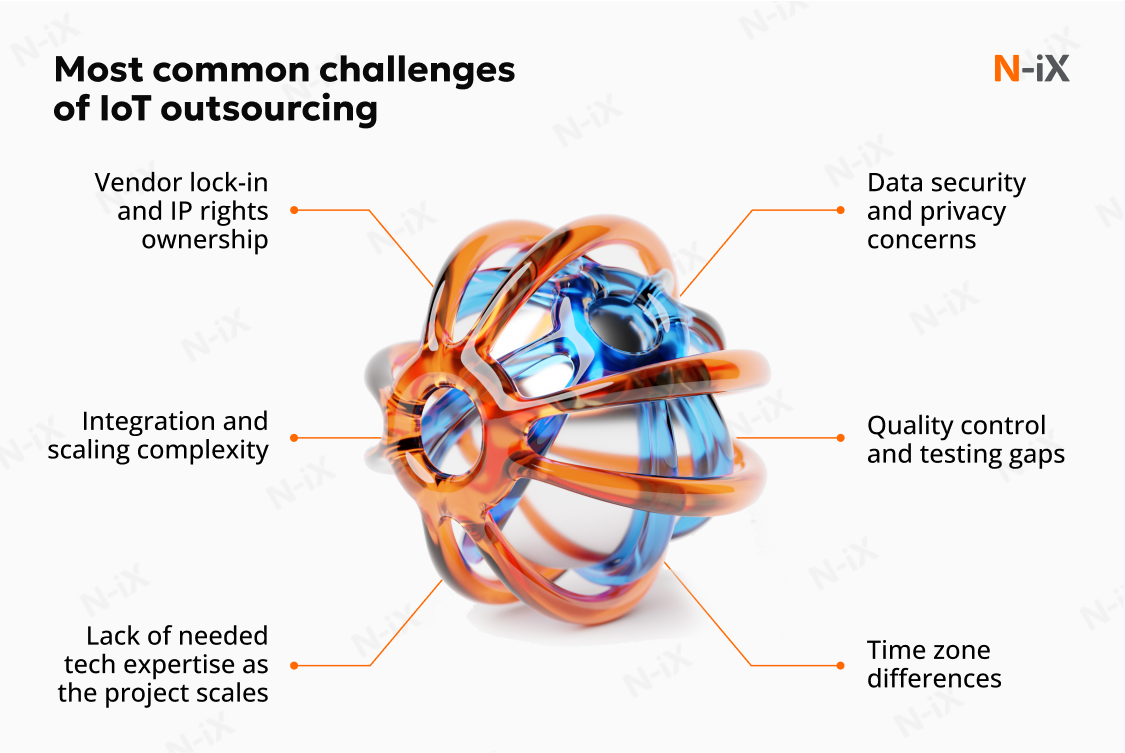
Data security and privacy concerns
According to the Eseye State of IoT Adoption report, security represents one of the most critical IoT implementation challenges [1]. And for a reason. IoT devices stream sensitive telemetry, such as location, usage patterns, patient, or driver data. A breach can cause businesses to face regulatory fines and reputational loss.
How N-iX mitigates it: We help our clients strengthen security at each IoT architecture layer (hardware, network, cloud, apps). Our engineers embed security into each step of the development process. It allows the creation of a safe environment for clients' and users' assets and data. We run threat modelling workshops up front, keep all code in an ISO 27001- and SOC 2-certified environment, encrypt data end-to-end, generate an SBOM for every build, and can integrate HSM-backed device identities for zero-trust deployments.
Quality control and testing gaps
Without a proper IoT-specific testing approach, critical defects may remain hidden until after connected devices are deployed in the field. For example, a sensor node might pass basic bench testing but fail under real-world signal interference or power fluctuations. It can result in costly recalls or firmware hotfixes.
How N-iX mitigates it: Our IoT experts apply proven IoT testing practices to catch issues early. We combine automated and manual quality assurance to validate device connectivity, basic interoperability, and performance under typical operating conditions. For firmware, we run static code analysis against industry standards. We also perform over-the-air update checks to verify stability before rollout.
Time zone differences
Significant time gaps (e.g., over 10 hours) and different communication styles can slow down design approvals and delay critical fixes. It all can cause unnecessary rework when updates aren't reviewed promptly. For example, a firmware change request might sit idle overnight, only to be discovered the next day that it needs adjustments. As a result, it may lead to postponed deadlines.
How N-iX mitigates it: We have delivery hubs in Central and Eastern Europe (Poland, Ukraine, Romania, Bulgaria) aligned with EU business hours. Our delivery location in Colombia works perfectly for nearshoring for businesses from North America, as they share similar working hours. In addition, our recently opened offices in India and Azerbaijan help cater to companies located in the APAC region. N-iX hires skilled IoT developers in 25 countries worldwide, helping you to set up an engineering team in the most convenient location. We run English-first Agile ceremonies and maintain consistent documentation. Moreover, we can provide a dedicated project manager to keep development cycles smooth.
Lack of needed tech expertise as the project scales
As the project progresses or undergoes transformation, the company may need more engineers than it originally planned. Some IoT outsourcing vendors may not have developers with the required skills available on short notice. In this case, finding the required experts may put the project on hold while forcing the business to pay the already involved team.
How N-iX mitigates it: We have over 2,400 software engineers on board with skills in software engineering, cloud solutions, data analytics, enterprise platform and RPA, AI, ML, MLOps, cybersecurity, computer vision, and more. With our resources and access to a global talent pool, we can find you the right expert without pausing development.
Integration and scaling complexity
According to HiveMQ's report on building Industrial IoT systems, about 80% of IoT projects fail to scale because of integration challenges and the inability to support scaling systems [2]. The reason for that lies in the variety of devices supporting different connectivity protocols that need to be unified to allow for a smooth data streaming. In addition, legacy systems can also become a stumbling block when it comes to expanding, since they may not support new protocols and technologies needed for digital transformation with IoT.
How N-iX mitigates it: N-iX designs scalable and interoperable IoT architectures. Our engineers unify heterogeneous devices and protocols through custom gateways, middleware, and API layers, ensuring seamless data flow across your IoT ecosystem. We handle integration with legacy systems by developing protocol converters, cloud connectors, and hybrid infrastructure. It helps bridge old and new technologies without disrupting operations. N-iX also implements scalable cloud-native infrastructure featuring load balancing, container orchestration, and automated provisioning. It enables your solution to handle an increasing number of connected devices without performance loss.
Vendor lock-in and IP rights ownership
Vendor lock-in often happens when IoT solutions are built on proprietary SDKs, closed cloud platforms, or custom hardware that only the original vendor can service. This can make switching providers or bringing in-house development costly and time-consuming. Intellectual property (IP) rights issues may also arise if the outsourcing contract grants the vendor partial or full ownership of source code, firmware, or designs. It may leave you dependent on them for updates, fixes, or scaling.
How N-iX mitigates it: N-iX structures every engagement so clients retain full ownership of source code, firmware, and infrastructure. We use open standards and interoperable technologies (e.g., MQTT, Zephyr RTOS, Kubernetes) to avoid technology lock-in.
If outsourcing IoT development is in your plan, check out these tips on how to make the process smooth from start to finish.
Expert tips for successful outsourcing IoT development
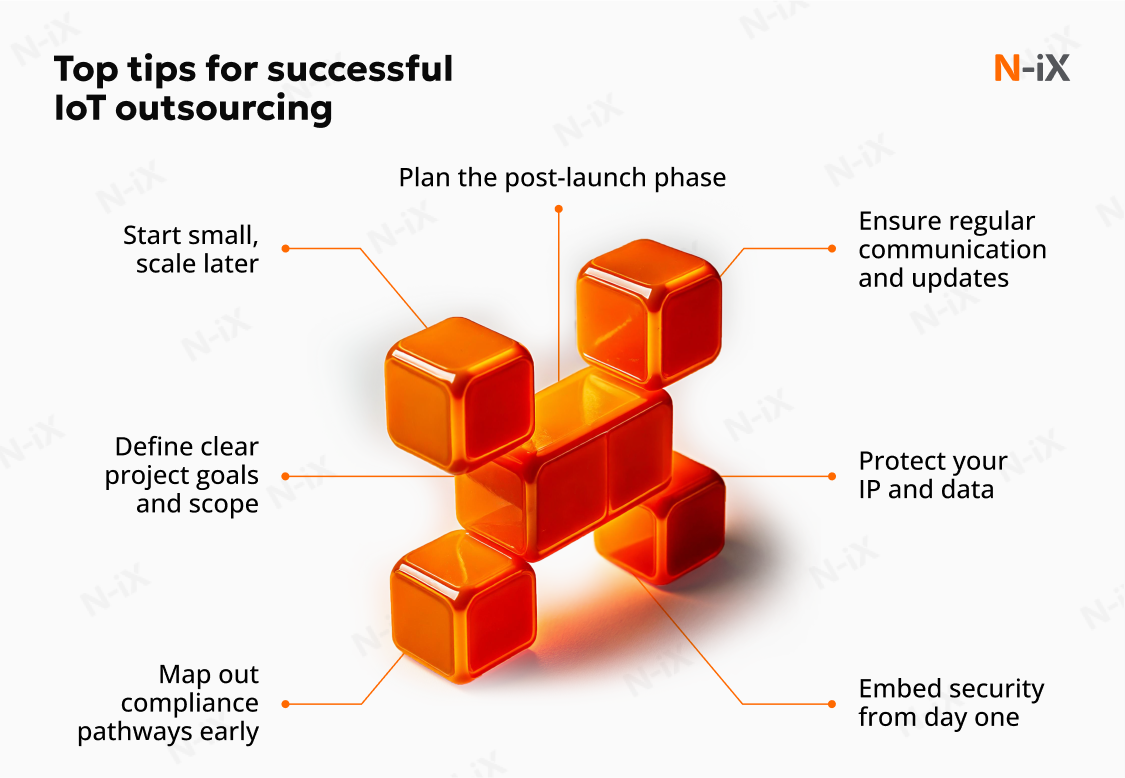
Define clear project goals and scope
A successful IoT project starts with well-defined, measurable objectives. Be specific about the scope, business goals, and the exact problems your solution will solve. Map out the outcomes you want to achieve and define key performance indicators so you can track progress and prove value along the way.
We recommend you to do market research to help you shape the expected result. Dig deep into your customers' needs and pain points to make sure you're building something they truly want and will use. If needed, we can provide you with tech consulting to ensure you're choosing the right development approach and technologies for your IoT project. This way, your IoT initiative is driven by real demand, not just the appeal of shiny new technology.
Start small, scale later
If you're new to outsourcing, start by delegating non-core IoT tasks and projects. It can help you manage the risks easier and also test whether this cooperation model or a specific partner is a good match for you.
In addition, IoT technology is always evolving. Starting small with pilot projects allows you to experiment, build prototypes, and expand as you develop expertise and insights from early solution use.
Ensure regular communication and updates
Effective communication holds outsourced projects together. Create a robust communication framework with designated meeting schedules and points of contact. Develop a communication matrix outlining channels, frequency, and content you expect during each meeting with the IoT outsourcing company.
Implement daily stand-ups and periodic retrospectives in agile environments. This maintains project coherence and promptly addresses potential obstacles.
Protect your IP and data
Protecting IP and sensitive data is a critical part of outsourcing IoT development. Ensure the contract clearly outlines each party's roles, responsibilities, and ownership rights. Signing non-disclosure agreements (NDAs) will help you safeguard confidentiality throughout development. You should also sign service level agreements (SLAs) to set measurable performance standards and quality expectations.
Robust data protection measures, from encryption to multi-factor authentication, add another layer of security. To reduce the risk of breaches, set up access controls to ensure that only authorized personnel can access sensitive information.
Embed security from day one
Building security into your IoT project from the start is far more effective and cost-efficient than resolving security issues after the release. Threat modeling, software bill of materials (SBOM) generation, and secure boot chains should be integral parts of the initial development backlog.
With the new Cyber Resilience Act (CRA) regulations in effect, you should start by identifying the security requirements prior to designing or building any PoCs. This proactive approach safeguards compliance, reduces risks, and protects long-term ROI.
Map out compliance pathways early
Compliance audits are an important stage of the solution development for further certification. Depending on your solution or product, identify the compliance needed and budget time and cost for respective audits. For example, they may be FCC/CE radio tests, ISO 27001 audits, or pen-tests at the planning stage. This way, you can avoid sudden project timeline changes and associated bottlenecks.
Plan the post-launch phase
Thinking ahead to the post-launch phase is just as critical as getting the product to the market. Clearly define who will handle over-the-air (OTA) updates, cloud cost management, and monitoring, if needed, to ensure reliable performance once devices are in the field. When outsourcing IoT development, define who will be responsible for solution maintenance to ensure maximum availability at all times.
How N-iX can help you with IoT project outsourcing
Outsourcing IoT development can be the catalyst that turns a bold idea into a market-ready solution faster, smarter, and more cost-efficient than building everything in-house. The key is partnering with a team that brings deep technical expertise, proven industry experience, and the infrastructure to support you from concept through long-term operation.
If you plan for onshore, nearshore, or offshore outsourcing for IoT development, N-iX's various industry expertise and tech skills are here to help your project. We have assisted businesses in manufacturing, logistics and supply chain, retail, telecom, automotive, healthcare, energy and utilities, and agritech industries to build successful IoT solutions.
Our core engagement models include Staff Augmentation, Managed Team, and Custom Solution Development for better flexibility. With over 60 successfully delivered IoT and embedded projects for global enterprises and mid-sized companies, our teams bring proven experience in firmware development, connected device engineering, industrial IoT, wearable app development, and embedded development.
If you're ready to explore how outsourcing can advance your IoT initiative, let's talk. We can provide a tailored project approach, share relevant case studies, and map a path from idea to launch so you can focus on scaling your business. And if your project needs skilled IoT engineers, we're here to help.
Sources:
- Eseye 2024 State of IoT Adoption | Eseye
- Building Industrial IoT Systems in 2024 | HiveMQ
Have a question?
Speak to an expert




